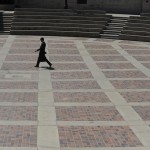5 Ways to Save Denver’s Civic Center Park [Denver Post]
While objections are certain, this is a thoughtful attempt to address a problem/opportunity that impacts our whole city.
POSTED: 08/06/2015
No patch of open land is more important to Denver’s history than Civic Center. Developed in the 1910s, just as the city itself was exploding, the park served as sacred space for political rallies and cultural gatherings that helped Denver define who it was and take its place as a great American metropolis. It still does that today, with events like Cinco de Mayo, Pridefest and even the annual 420 Rally tracking the evolution of the citizenry.
But, in the most important ways, Civic Center is failing us, and just when we need it the most. The city is once again a boomtown with buildings rising and every square inch of the urban core waiting for developers to cover it in concrete. Parks, active, attractive and engaging, are the one way we can preserve our quality of life downtown.
Civic Center is none of those things. The place is packed on a relatively few festival weekends during the summer, but other than that it is forsaken. Empty, despite its manicured landscaping, iconic art works and classic architecture. The few people who go there don’t linger; they use it as a pass through to get from the 16th Street Mall to the city’s main library and art museum. It’s not a destination for families or first dates, or even — and, remember, this is Colorado — joggers, bikers and skateboarders.
The people who do stick around might have no other option. They are often homeless or hungry, lined up a hundred strong each day at noon when a local charity passes out free sack lunches.
There are some exceptions. The McNichols Building, the former Carnegie Library converted into galleries and offices, is a popular space for events. Food trucks bring big crowds for midday hours on Thursday.
But 15 minutes after the food trucks leave, the park is once again empty. There’s rarely more than a handful of people, usually less than a dozen, enjoying the space, and almost no one sits down.
There have been scores of ideas for making the park a real destination. Master plan after master plan. Small ideas and big ones. Nothing has worked.
Money falls through, or preservationists object to the changes. Civic Center, designated a National Historic Landmark in 2012, was part of the important City Beautiful movement of the early 20th century, which, among other things, encouraged industrializing cities to retain healthy open space for growing populations. They didn’t have pollution control back then, or air conditioning.
But times have changed. Civic Center is, indeed, a landscape worth preserving; no one doubts that. But Denver can’t afford to have a park no one uses, a wasted space, designed for another age, and idle in our own.
Real preservation is about sustaining the spirit of a place as much as its physical structure, and there we have failed. This would be a good moment to try again.
There’s some reason to believe now is the time. The city’s Parks Department is embarking on a major effort to increase the amount of open space downtown. It wants new parks and better-used parks to balance all the recent construction. The Denver Art Museum is planning a major renovation of its North Building, the 1971 tower designed by architect Gio Ponti, that is right across 14th Street. Both efforts could impact Civic Center.
Balance is in order. Nothing good will happen to Civic Center if we hold too fast to the past or bound too quickly toward an unknown future.
But there are things, sweeping and subtle, that might make a huge difference.
1. The big move that could change everything
2. The no-brainer: Make it a real park
3. Shakespeare’s help: Use that amphitheatre
![]()




Comments
5 Ways to Save Denver’s Civic Center Park [Denver Post] — No Comments
HTML tags allowed in your comment: <a href="" title=""> <abbr title=""> <acronym title=""> <b> <blockquote cite=""> <cite> <code> <del datetime=""> <em> <i> <q cite=""> <s> <strike> <strong>